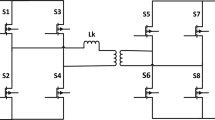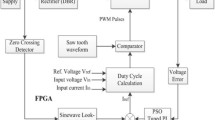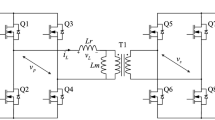Abstract
The dual active bridge (DAB) is amongst the popular DC-DC converter in literature due to its attractive feature such as bidirectional power flow, galvanic isolation and high power density. The conventional proportional-integral (PI) controller is a controller that has been widely used in power electronics field including DAB converter due to its reliability. However, it has less performance especially at the condition that far from the point of tuning. This paper proposes an online tuning of phase-shift angle using particle swarm optimization (PSO) algorithm for the 200 kW 20 kHz DAB system. The system is controlled directly by PSO without the existence of PI controller. Simulation has been carried out with the objective to minimize the steady-state error, eSS of the DAB. The DAB performance with the proposed solution is evaluated in terms of eSS by testing the system under various reference voltages at different loads. Comparative analysis between the proposed method and the PI using Ziegler-Nichols (ZN-PI) method performance are presented. In order to validate the simulation results, a hardware-in-the-loop (HIL) experimental circuit is built in Typhoon HIL-402 to verify the steady state performance of the system. The DAB system with proposed method produces higher accuracy by producing smaller eSS as compared to the DAB system with ZN-PI method.
Access this chapter
Tax calculation will be finalised at checkout
Purchases are for personal use only
Similar content being viewed by others
References
Lu Y, Wu Q, Wang Q, Liu D, Xiao L (2018) Analysis of a novel zero-voltage-switching bidirectional DC/DC converter for energy storage system. IEEE Trans Power Electron 33(4):3169–3179
Rodriquez A, Aitor V, Lamar DG, Hernando MM, Sebastia J (2015) Different purpose design strategies and techniques to improve the performance of a dual active bridge with phase-shift control. IEEE Trans Power Electron 30(2):790–804
Shi L, Lei W, Li Z, Cui Y, Huang J, Wang Y (2017) Stability analysis of digitally controlled dual active bridge converters. J Mod Power Syst Clean Energy 6(2):1–9
Qinglei B, Wen H, Wen J, Yihua H, Yang D (2020) Transient DC Bias elimination of dual-active-bridge DC–DC converter with improved triple-phase-shift control. IEEE Trans Industr Electron 67(10):8587–8598
Wei S, Zhao Z, Li K, Yuan L, Wen W (2021) Deadbeat current controller for bidirectional dual-active-bridge converter using an enhanced SPS modulation method. IEEE Trans Power Electron 36(2):1274–1279
Awal MA et al (2020) Capacitor voltage balancing for neutral point clamped dual active bridge converters. IEEE Trans Power Electron 35(10):11267–11276
Liu B, Davari P, Blaabjerg F (2021) Nonlinear coss −VDS Profile Based ZVS range calculation for dual active bridge converters. IEEE Trans Power Electron 36(1):45–50
Sathishkumar P et al (2017) A blended SPS-ESPS control DAB-IBDC converter for a standalone solar power system. Energies 10:1–19
Bal S, Yelaverthi DB, Rathore AK, Srinivasan D (2018) Improved modulation strategy using dual phase shift modulation for active commutated current-fed dual active bridge. IEEE Trans Power Electron 33(9):7359–7375
Ishaque K, Salam Z, Shamsudin A, Amjad M (2012) A direct control based maximum power point tracking method for photovoltaic system under partial shading conditions using particle swarm optimization algorithm. Appl Energy 99:414–422
Konstantopoulos GC, Baldivieso-monasterios PR (2019) Nonlinear PI controller for systems with state constraint requirements. In: 18th European Control Conference, IEEE, Italy, pp 1642–1647
Chacko S, Bhende CN, Jain S, Nema RK (2016) PSO based online tuning of PI controller for estimation of rotor resistance of indirect vector controlled induction motor drive. In: International Conference on Electrical, Electronics, and Optimization Techniques, IEEE, India, pp 4606–4611
Babu TS, Rajasekar N, Sangeetha K (2015) Modified particle swarm optimization technique based maximum power point tracking for uniform and under partial shading condition. Appl Soft Comput 34:613–624
Renaudineau H et al (2015) A PSO-based global MPPT technique for distributed PV power generation. IEEE Trans Ind Electron 62(2):1047–1058
Eltamaly A, Farh HMH, Al MS, Saud (2019) Impact of PSO reinitialization on the accuracy of dynamic global maximum power detection of variant partially shaded PV systems. Sustainability 11(7):2091
Liu P, Chen C, Duan S, Zhu W (2017) Dual phase-shifted modulation strategy for the three-level dual active bridge DC-DC converter. IEEE Trans Ind Electron 64(10):7819–7830
Gu Q, Yuan L, Nie J, Sun J, Zhao Z (2019) Current stress minimization of dual-active-bridge DC–DC converter within the whole operating range. IEEE J Emerg Sel Top Power Electron 7(1):129–142
Eswaran T, Kumar VS (2017) Particle swarm optimization (PSO)-based tuning technique for PI controller for management of a distributed static synchronous compensator (DSTATCOM) for improved dynamic response and power quality. J Appl Res Technol 15(2):173–189
Faisal SF, Beig AR, Thomas S (2020) Time domain particle swarm optimization of PI controllers for bidirectional VSC HVDC light system. Energies 13(866):1–15
De Doncker RWAA, Divan DM, Kheraluwala MH (1991) A three-phase soft-switched high-power-density DC/DC converter for high power applications. IEEE Trans Ind Appl 27(1):63–73
Yaqoob M, Loo KH, Lai YM (2017) Extension of soft-switching region of dual-active-bridge converter by a tunable resonant tank. IEEE Trans Ind Electron 32(12):9093–9104
Buticchi G, Barater D, Costa LF, Liserre M (2018) A PV-inspired low-common-mode dual-active-bridge converter for aerospace applications. IEEE Trans Ind Electron 33(12):10467–10477
Yan Y, Gui H, Bai H (2021) Complete ZVS analysis in dual active bridge. IEEE Trans Ind Electron 36(2):1247–1252
Dao ND, Lee D, Phan QD (2020) High-efficiency SiC-based isolated three-port DC/DC converters for hybrid charging stations. IEEE Trans Power Electron 35(10):10455–10465
Shi L, Lei W, Li Z, Huang J, Cui Y, Wang Y (2017) Bilinear discrete-time modeling and stability analysis of the digitally controlled dual active bridge converter. IEEE Trans Power Electron 32(11):8787–8799
Akagi H, Yamagishi T, Tan NML, Kinouchi S, Miyazaki Y, Koyama M (2015) Power-loss breakdown of a 750-V 100-kW 20-kHz bidirectional isolated DC – DC converter using SiC-MOSFET/SBD dual modules. IEEE Trans Ind Appl 51(1):420–428
Haneda R, Akagi H (2020) Design and performance of the 850-V 100-kW 16-kHz bidirectional isolated DC–DC converter using SiC-MOSFET/SBD H-bridge modules. IEEE Trans Power Electron 35(10):10013–10025
Henao-Bravo EE, Ramos-Paja CA, Saavedra-Montes AJ, González-Montoya D, Sierra-Pérez J (2020) Design method of dual active bridge converters for photovoltaic systems with high voltage gain. Energies 13:1–31
Kennedy J, Eberhart R (1995) Particle swarm optimization. In: International Conference on Neural Networks, Australia, pp 1942–1948
Rashidi M, Nasiri A, Cuzner R (2016) Application of multi-port solid state transformers for microgrid-based distribution systems. In: IEEE International Conference on Renewable Energy Research and Applications, IEEE, UK, pp 605–610
Acknowledgements
This work is supported by Faculty of Electrical and Electronics Engineering Technology, Universiti Malaysia Pahang, under research grant RDU190318.
Author information
Authors and Affiliations
Corresponding author
Editor information
Editors and Affiliations
Rights and permissions
Copyright information
© 2022 The Author(s), under exclusive license to Springer Nature Singapore Pte Ltd.
About this paper
Cite this paper
Ab-Ghani, S., Daniyal, H., Ramlan, N.H., Saad, N.M., Tiong, M.C. (2022). A High Accuracy Control of Dual Active Bridge DC-DC Converter Using PSO Online Direct Tuning. In: Md. Zain, Z., Sulaiman, M.H., Mohamed, A.I., Bakar, M.S., Ramli, M.S. (eds) Proceedings of the 6th International Conference on Electrical, Control and Computer Engineering. Lecture Notes in Electrical Engineering, vol 842. Springer, Singapore. https://doi.org/10.1007/978-981-16-8690-0_26
Download citation
DOI: https://doi.org/10.1007/978-981-16-8690-0_26
Published:
Publisher Name: Springer, Singapore
Print ISBN: 978-981-16-8689-4
Online ISBN: 978-981-16-8690-0
eBook Packages: Intelligent Technologies and RoboticsIntelligent Technologies and Robotics (R0)




